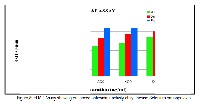Antioxidant activity and green synthesis of selenium nanoparticles using allium sativum extract
Keywords:
Green synthesis, Selenium nanoparticles, Allium sataivum, antioxidant potentialAbstract
The green synthesis of nanoparticles has provided cost effective, environment friendly procedure and raising safe strategies for synthesis of non-materials. In this study we investigated the clove of Allium sataivum, which is used for the synthesis of Selenium nanoparticles. The biosynthesized selenium nanoparticles were characterized by using UV-Visible (UV-VIS) spectrophotometer, Transmission electron microscopy (TEM), Fourier transform spectroscopy (FT-IR) and Energy dispersive X-Ray spectroscopy (EDAX). The selenium nanoparticles synthesized by garlic were observed as hollow and spherical particles in size ranging 7-45nm which is found more stable more than two months. The present study also reports the efficiency of ABTS, DPPH and FRAP assay to estimate the antioxidant potential of selenium nanoparticles which synthesized by garlic extract.
References
Deepa B and Ganesan V. Biogenic Synthesis and Characterization of Selenium Nanoparticles Using the Flower of Bougainvillea spectabilis Willd. International Journal of Science and Research (IJSR) 2013; 4:690-695.
Shankar SS, Akhilesh Rai, Balaprasd Ankamwar, Amit Singh, Absar Ahmad and Murali Sastr. Biological synthesis of trigonular gold nanoprisms. Applied Nanoscience 2004;1:69-77.
Gebeshber IC, Stachelberger H, Ganji BA, Fu DC,Yunas J and Majlis BY. Exploring the Innovational Potential of Biomimetics for Novel 3D MEMS. Advanced Materials Research 2009;74:265-268.
Prathnaa TC, Chandrasekarana N, Ashok M. Raichurb and Amitava Mukherjeea. Biomimetic synthesis of silver nanoparticles by Citrus limon (lemon) aqueous extract and theoretical prediction of particle size. Colloids and Surfaces B: Biointerfaces. 2011;82:152-159.
Deendayal Mandal, Mark E. Bolander, Debabrata Mukhopadhyay, Gobinda Sarkar, Priyabrata Mukherjee. The use of microorganisms for the formation of metal nanoparticles and their application. Applied Microbial Biotechnology. 2006;69:485-492.
Kavita KS, Syed Baker, Rakshith D, Kavitha HU, Yashwantha Rao HC, Harini BP and Satish S. Plants as green source towards synthesis of nanoparticles. International Research Journal of Biological Sciences. 2013;2:66-76.
Ramamurthy CH, Sampath KS, Arun kumar P, Suresh Kumar M, Sujatha V, Prem kumar K, Thirunavukkarasu C. Green synthesis and characterization of selenium nanoparticles and its augmented cytotoxicity with doxorubicin on cancer cells. Bioprocess Biosyst Eng. 2013; 36:1131–1139.
Mojtaba Shakibaie, Ahmad Reza Shahverdi, Mohammad Ali Faramarzi, Gholam Reza Hassanzadeh, Hamid Reza Rahimi and Omid Sabzevari. Acute and subacute toxicity of novel biogenic selenium nanoparticles in mice. Pharmaceutical Biology. 2012; 51:58–63.
Parisa Jafari Fesharaki, Pardis Nazari, Mojtaba Shakibaie, Sassan Rezaie, Maryam Banoee, Mohammad Abdollahi and Ahmad Reza Shahverdi. Biosynthesis of selenium nanoparticles using Klebsiella pneumonia and their recovery by a simple sterilization process. Brazilian Journal of Microbiology.2010;41:461-466.
Bijan Zare, Shabnam Babaie, Neda Setayesh and Ahmad Reza Shahverdi. Isolation and characterization of a fungus for extracellular synthesis of small selenium nanoparticles. Nanomedicine journal. 2013;1:13-19.
Harikrishnan Hariharan, Naif Abdullah Al-Harbi, Ponmurugan Karuppiah and Shyam Kumar Rajaram. Microbial synthesis of selenium nanocomposite using Saccharomyces cerevisiae and its antimicrobial activity against pathogens causing nosocomial infection. Chalcogenide Letters. 2012;9:509-515.
Kumar Suranjit Prasad, Hirnee Patel, Tirtha Patel, Khusbu Patel and Kaliaperumal Selvaraj. Biosynthesis of Se nanoparticles and its effect on UV-induced DNA damage. Colloids and Surfaces B: Biointerfaces. 2013;103:261–266.
Garima Sharma, Ashish Ranjan Sharma, Riju Bhavesh, Jongbong Park, Bilguun Ganbold, Ju-Suk Nam and Sang-Soo Lee. Biomolecule-Mediated Synthesis of Selenium Nanoparticles using Dried Vitis vinifera (Raisin) Extract. Molecules. 2014;19:2761-2770.
Danielle M. Dick and Arpana Agrawal. The genetics of alcohol and other drug dependence. Alcohol Research and Health. 2003;31:111-118.
Coppinger RJ and Diamond AM. Selenium deficiency and human disease, Selenium: its molecular biology and role in human health. Kluwer Academic Publishers, Norwell. 2001;1:219-233.
Dejian Huang , Boxin Ou and Ronald L. Prior. The chemistry behind antioxidant capacity assays. Journal of Agriculture and Food Chemistry. 2005;53:1841–1856.
Rajurkar NS and Kunda Gaikwad. Evaluation of phytochemicals, antioxidant activity and elemental content of Adiantum capillus veneris leaves. Journal of Chemical and Pharmaceutical Research. 2012;4:365-374.
Leong P and Shui G. An investigation of antioxidant capacity of fruits in Singapore markets. Food Chemistry 2002; 76:69–75.
Maria I. Gil Francisco A. Tomas-Barberan, Betty Hess-Pierce and Adel A. Kader. Antioxidant capacities, phenolic compounds, carotenoids, and vitamin C contents of nectarine, peach, and plum cultivars from California. Journal of Agricultural and Food Chemistry. 2002; 50:4976–4982.
Changjiang Guo, Jijun Yang, Jingyu Wei, Yunfeng Li, Jing Xu and Yugang Jiang. Antioxidant activities of peel, pulp and seed fractions of common fruits as determined by FRAP assay. Nutrition Research. 2003; 23:1719-1726.
Antonio Jiménez‐Escrig, Isabel Jiménez‐Jiménez, Raquel Pulido and Fulgencio Saura-Calixto. Antioxidant activity of fresh and processed edible seaweeds. Journal of the Science of Food and Agriculture. 2001;81:530-534.
Boxin Ou, Maureen Hampsch-Woodil and Ronald L. Prior. Development and validation of an improved oxygen radical absorbance capacity assay using fluorescein as the fluorescent probe. Journal Agriculture Food Chemistry. 2001;49:4619-4626.
Krien Thaipong, Unaroj Boonprakob, Kevin Crosby, Luis Cisneros- Zevallos and David Hawkins Byrne. Comparison of ABTS, DPPH, FRAP and ORAC assays for estimating antioxidant activity from guava fruit extracts. Journal of Food Compositions and Analysis. 2006;19:669-675.
Kavita KS, Syed Baker, Rakshith D, Kavitha HU, Yashwantha Rao HC, Harini BP and Satish S. Plants as Green Source towards Synthesis of Nanoparticles. International Research Journal of Biological Sciences. 2013;2:66-76.
Nidhi Singh, Prasenjit Saha, Karthik Rajkumar and Jayanthi Abraham. Biosynthesis of silver and selenium nanoparticles by Bacillus sp. JAPSK2 and evaluation of antimicrobial activity. Der Pharmacia Lettre. 2014;6:75-181
Shreya Medda, Amita Hajra, Uttiya Deym, Paulomi Bose and Naba Kumar Mondal. Biosynthesis of silver nanoparticles from Aloe vera leaf extract and antifungal activity against Rhizopus sp. and Aspergillus sp. Applied Nanoscience. 2014;5:875–880.


